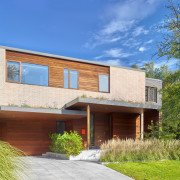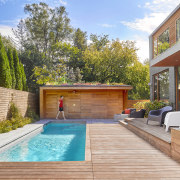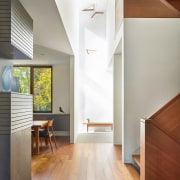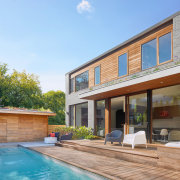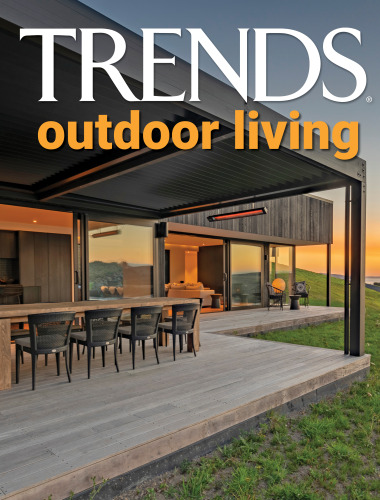Realm of the senses
A contemporary sensory-rich, biophilic home is a considered response to the owner’s desire for a sustainable residence inspired by nature, strongly connected to the outdoors and awash in daylight

Designed by Dubbeldam Architecture + Design
From the architects:
For this home and garden, the Dubbeldam team drew upon biophilic design strategies incorporating many key principles for building visual and non-visual connections with the outdoors.
Biophilic design dates back to the mid-1980s, but in recent years it has become a larger part of sustainable practices due to the growing wellness movement and a greater desire to live and work in healthier interiors.
The term describes a conscious effort to link the built environment to the natural world, through various sensory experiences including sight, sound, touch, and smell.
The garden-focussed house is imbued with wellness features, including a palette of natural materials, lush landscaping, and water features that offer both visual and auditory effects to enhance a sense of calmness.
It also uses spatial strategies to maximise natural light and to visually connect to the outdoors through ample fenestration and elevated vantage points.

Upon entry into the house, a direct view to the backyard lap pool and landscaping is visible through a tall, narrow window on-axis.
Looking back toward the front entry, a double-height space dramatically showcases the home’s dynamic spatial qualities, enhanced by the light that pours in from the tall windows and the abstracted shadows cast by the triangular light fixtures overhead.
Views are primarily oriented to the rear yard, with access through wall-to-wall sliding doors in the kitchen.
A hot tub built into the hard-wearing Cumaru outdoor decking and firepit on the small patio transform the backyard into a relaxing oasis for three out of four seasons.

A focal point of the interior is the central staircase crafted of solid mahogany and featuring open risers and a curved balustrade that emulates natural organic forms, inviting the hand to run along its sculptural contours.
Light filters through an operable skylight, providing natural illumination and ventilation in the centre of the home, while simultaneously offering a view of the sky.
Inspired by the homeowner’s love for Prairie Style architecture, the exterior of the house incorporates horizontal planes and overhangs, and an earthy, natural material palette of brick, wood, and stone.
Buff and grey-toned brick convey a sense of solidity while Western red cedar boards and mahogany-framed windows complement the warmth of wood.

Green roofs are integrated into each of the overlapping roof planes on the front and back of the house, while their soffits are detailed with the Brazilian hardwood massaranduba.
Integral to the front of the house is the pear tree that was retained on-site; located in front of the large dining-room window, its foliage casts an animated play of shadow and light year-round, while the scent of blossoms in spring and ripe fruit in autumn wafts through the open window.
Complementing the home’s biophilic design strategy is the prioritisation of sustainability approaches and systems such as radiant in-floor heating, efficient high-velocity cooling, thermally superior wall assemblies, and operable windows and skylights for natural ventilation and daylighting,
In addition, the home features LED light fixtures, low-flow plumbing fixtures, and durable, hard-wearing and low-VOC materials.
Credit list
Architecture and interior design
Project team
Landscape design
Home kitchen bathroom commercial design
